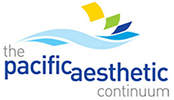
Dr. Jack Griffin
Trendy Indirect Materials
There are generally three materials that dominate crown and bridge materials today; lithium disilicate, anterior zirconia, posterior zirconia. All have an excellent record of clinical success and can meet the esthetic demands of many clinical situations with or without layering porcelain and customization.
For conservative restorations like veneers, where most, if not all, of the adhesion is to enamel, a silica based ceramic like lithium disilicate is hard to beat. Plus, when bonded to etched enamel with a bonding agent and composite luting material, the longevity is undeniably excellent. Monolithic lithium disilicate has a flexural strength of 360-400 MPa, which is quite good with an excellent history of service if the preparation and cementation are sufficient whether in the anterior or posterior.
Zirconia has become the market leader in volume because simply put, it works well. Anterior (high translucency) zirconia has less flexural strength (750-850 MPa) than its older, more opaque posterior zirconia cousin (1050-1300 MPa) and can often give a more natural vitality because of this. There is now even a choice to have both the more translucent anterior and more strength posterior zirconia blended in one restoration (e.mx ZirCAD Prime (Ivoclar) resulting in arguably the best esthetics ever in a non-layered restoration.
Monolithic Anterior Zirconia Case
In this case, the patient had interproximal decay, failing restorations, irritated gingiva, uneven color, and a worn dentition. (Fig 1-4)
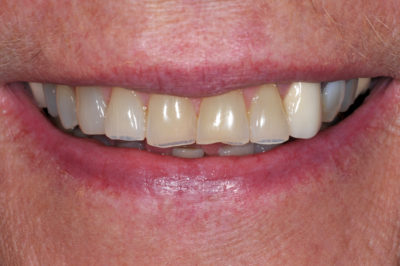
Figure 1
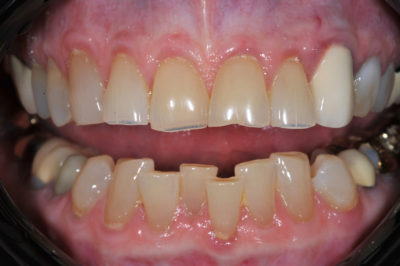
Figure 2
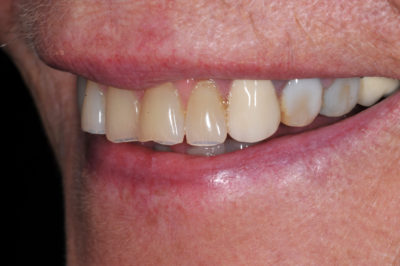
Figure 3
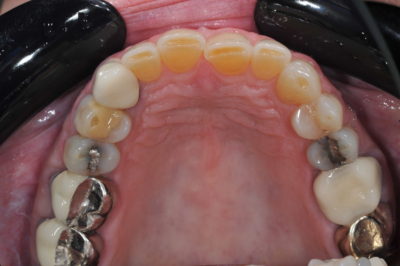
Figure 4
Teeth were prepped, decay removed, build-ups done, and impressions taken. (Fig 5) Teeth were cleaned with 2% chlorhexidine (Cavity Cleanser, Bisco) and temporaries placed in the shade closest to what the patient chose for the final restorations (ProV Temp, Bisco). All records were sent to the laboratory with a complete set of pre-op and procedure photos. After one week in temporaries, the patient returned for a follow up to evaluate color, length, and experience with the temps. (Fig 6) Polishing was done, photos taken, and desired changes communicated with the laboratory.
The preps were conservative but done in full coverage to cover old restorations, decay, and missing enamel. (Fig 7) Anterior zirconia full coverage restorations in shade 0.5M1 as the patient chose were made in this case. (Fig 8) This material is opaque enough to cover the color of the model underneath but transparent enough to maintain vitality when placed in the mouth. (Fig 9) The laboratory put facial anatomy and slight character stain in the glaze for an excellent aesthetic result. (Fig 10)
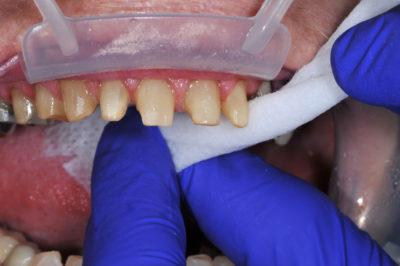
Figure 5
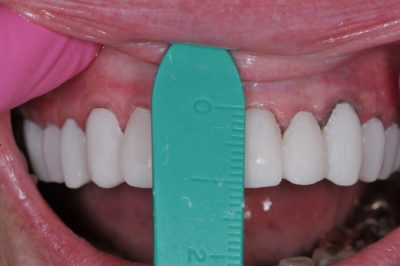
Figure 6
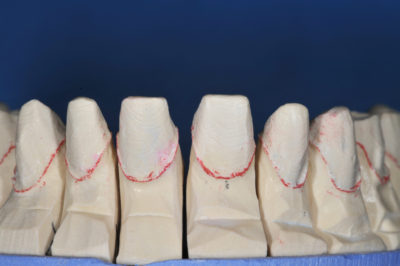
Figure 7
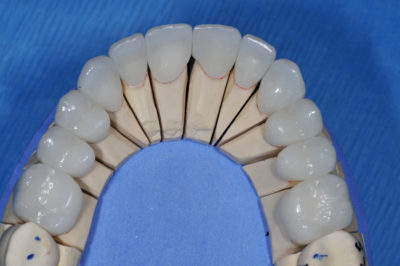
Figure 8
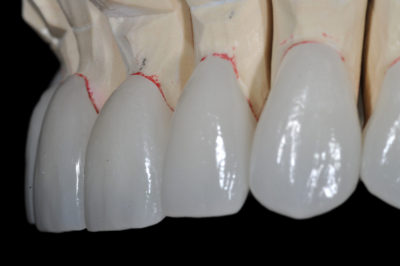
Figure 9
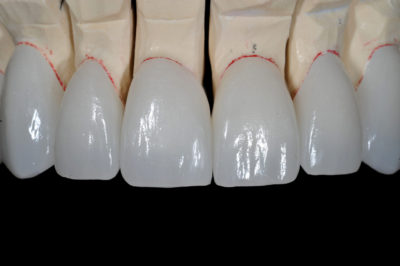
Figure 10
Bio-interactive Cementation
At the insertion appointment, the temps were removed, restorations tried in, a cleaner applied (ZirClean, Bisco), rinsed, and dried. (Fig 11) Anterior zirconia has the strength to be cemented with almost any material but the trend today is to use a regenerative, bio-interactive, self-adhesive, dual-cure cement because of its excellent tissue response, fluoride, and calcium release (TheraCem, Bisco). (Fig 12) The teeth were isolated, cleaned again with 2% chlorhexidine, and restorations placed two at a time starting with the central incisors and working posteriorly. (Fig 13-14)
We allow the chemical cure to begin first without light curing and start clean up after initial set by pushing up down at each papilla, going around the margins with a CH3 explorer, and removing the semi-set material in several large pieces. (Fig 15) This easy to clean up cement is light-cured only after complete clean up including flossing. Not also the transparency of the anterior zirconia when the curing light is applied. (Fig 16)
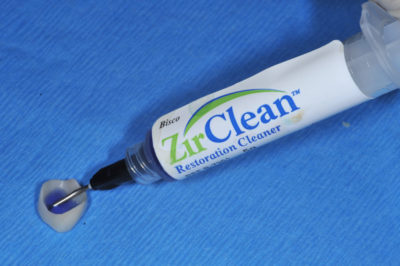
Figure 11
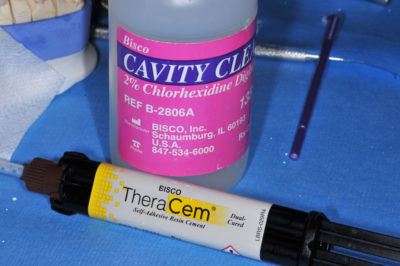
Figure 12
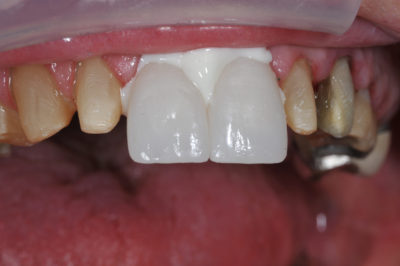
Figure 13
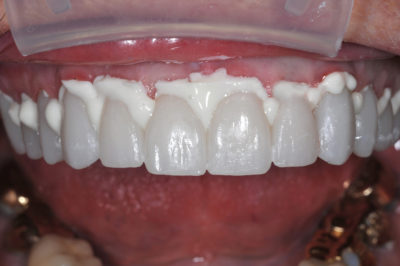
Figure 14
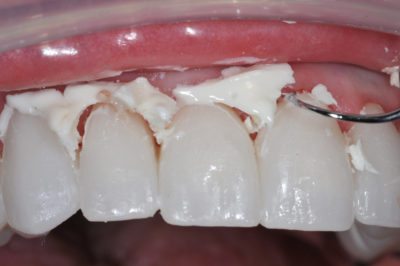
Figure 15
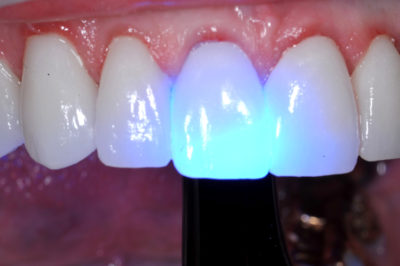
Figure 16
Critique
The soft tissue response is good. (Fig 17) The noted translucency of these monolithic restorations is good even with this light shade with a slight influence of the preparations underneath in the gingival 2/3 of each one. (Fig 18). The value of monolithic restorations can be excellent depending upon the clinical situation and patient circumstances. (Fig 19-20)
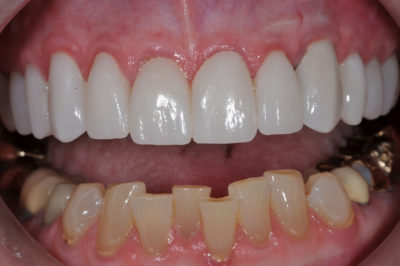
Figure 17
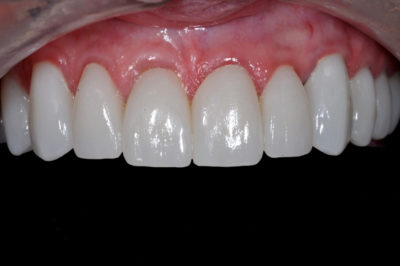
Figure 18
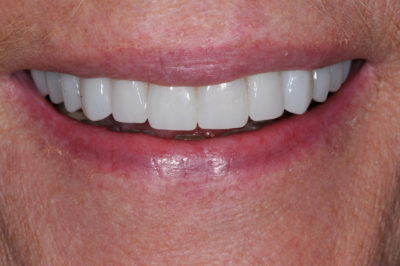
Figure 19
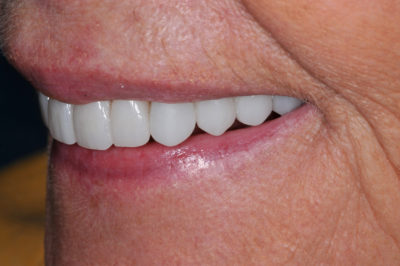
Figure 20
PAC Support
The PAC team is excellent at planning a case from start to finish and can help you when determining what prep design and materials would be preferred in that particular case.
If you have questions about my article or if you would like to send a case, please contact the Pacific Aesthetic Laboratory Group at www.pacificaestheticdentalstudio.com, Gary Vaughn, CDT, CTO, (888) 461-3331, or via email [email protected].
